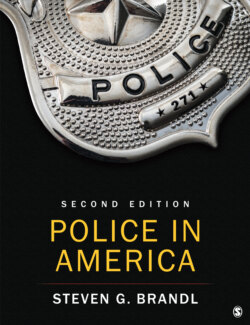Читать книгу Police in America - Steven G. Brandl - Страница 146
На сайте Литреса книга снята с продажи.
Technology on the Job
ОглавлениеThe Continuum of Force, OC Spray, and Tasers
Although use of force is discussed in detail in Chapter 11, it is useful to introduce the concept of the continuum of force and less lethal force here.
There are many different versions of the continuum of force, but the basic idea behind all of them is that the police must only use as much force as necessary to overcome the resistance offered by a noncompliant subject. The initial steps on the continuum consist of officer presence and verbal commands. If these forms of force do not induce compliance, then it is appropriate to use physical force. The most common form of physical force is bodily force wherein officers use their bodies to gain control and compliance over subjects. If bodily force does not work, then a weapon such as a Taser or oleoresin capsicum (OC) spray is appropriately used. Finally, if none of these options produces subject compliance or is appropriate given the situation (for example, the subject is armed and poses an immediate threat to officers or citizens), then deadly force (via a firearm) would be appropriately used.
OC spray and Tasers are generally considered to be forms of force that are less likely to be lethal, at least when compared to firearms. OC is an inflammatory agent naturally found in cayenne peppers. Ideally, when a person is sprayed in the face with OC, the effects are immediate: The respiratory tract becomes inflamed; the subject experiences an intense burning sensation and swelling around the eyes, which close involuntarily; and the subject is no longer able to resist. Police departments have been using OC spray since the 1980s.
TASER (short for Thomas A. Swift Electric Rifle) is the brand name of an electronic stun device and is the most popular such device on the market. Tasers were first introduced in police departments in the 1990s. A Taser resembles a gun. When the trigger is pulled, two wired probes are discharged from the gun and fired into the body of a subject. An electrical current then runs from the weapon through the wires and into the subject’s body. When both probes attach to the subject, the Taser delivers the electrical current, which overrides the central nervous system. This causes involuntary muscle contractions and the incapacitation of the resisting subject. The weapon can also be used in drive-stun mode. In this mode, the weapon itself is placed in contact with the subject’s body to deliver the electrical current. Used in this way, the weapon causes localized pain that can be used to allow officers to overcome the resistance of the subject. In many police departments, the use of a Taser in drive-stun mode is discouraged or even prohibited except in extreme circumstances.
A Question to Consider 4.1 Does the Authority to Use Force Really Make the Police Unique?
Although it has been argued that authority to use force differentiates the police occupation from all others, upon further reflection, it appears that people in many other occupations also have the authority to use force—for example, bouncers at a bar, football players, soldiers, and martial arts fighters. But how does police authority to use force differ from these occupations? Explain your answer. Hint: Think about the situations in which the police can use force, compared to people in these other occupations.
Using this line of reasoning, the tools used by police include handcuffs, batons, firearms, pepper spray, and Tasers, among others. Arguably, the most important tool of the police is their ability to use force, or at least the threat of force (see Technology on the Job feature). The police have the authority to use force so that people listen to them and obey their orders. If the police are responsible for regulating the conduct of citizens, having such a tool can certainly help. Citizens might obey the orders of the police because, if they do not, the police may use force upon them. Indeed, scholars have identified police authority to use force as the central feature of the police function—a feature that differentiates the police occupation from all others.23 However, it is not just the authority to use force that makes the police unique; it is that the police can potentially use force in virtually any situation or location.
Photo 4.4 Many of the tools of the police, such as Tasers and firearms, relate to the use of force against subjects. Scholars argue that the authority to use force makes the police a unique and inherently controversial occupation.
AP Photo/Alex Milan Tracy
Police use of force is controversial to say the least, especially when force is used in situations where it may not be justified or necessary and/or when the force being used is deadly. Police use of force, justified or not, never photographs well. Part of the issue here is that citizens and police officers (as well as prosecutors, judges, and juries) may disagree about whether the force used was actually necessary. Many of the urban riots in the 1960s began as a result of incidents in which white officers shot African American citizens. In 1991, areas of Los Angeles burned and businesses were looted after the white officers who beat Rodney King, an African American man, were found not guilty of assault by a jury (several officers were later found guilty on federal charges). In 2014, 2015, 2016, and 2017, cities across the country saw demonstrations, marches, and, in some places, riots to protest the killing of black men by white officers in New York City; Baltimore, Maryland; Ferguson, Missouri; Baton Rouge, Louisiana; and other cities. The sniper killing of five police officers in Dallas, Texas, in 2016 was apparently motivated by two high-profile police killings of black men that same year.
